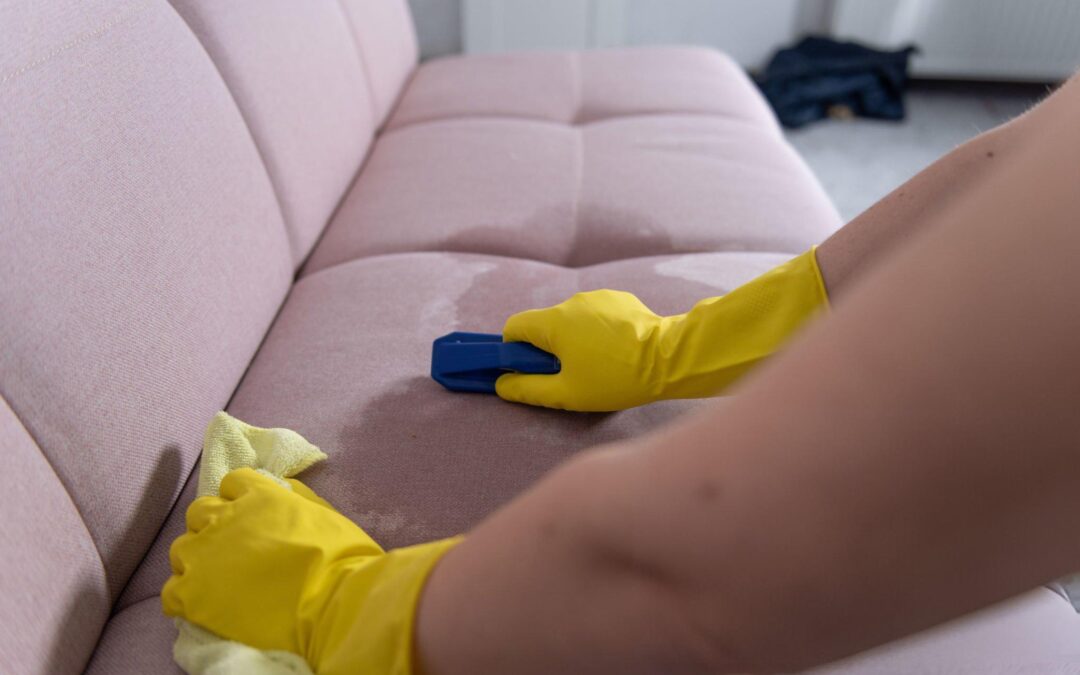Summer is the season of sunshine, backyard gatherings, and weekends by the lake—but it also brings unique challenges when it comes to keeping your home clean. One of the most overlooked culprits? Sunscreen and lotion stains on your furniture. After a day of outdoor fun, it’s easy to kick back on the couch without realizing that those protective creams can leave behind greasy, hard-to-remove marks.
While sunscreen is essential for your skin, it’s less than ideal for your upholstery. These products are designed to stick, and that means they often cling just as stubbornly to fabric as they do to your arms and legs. If left untreated, they can leave visible stains and even damage your furniture over time.
Let’s explore why these stains happen, what to do when they show up, and how to prevent them—so your furniture stays fresh all summer long.
Why Sunscreen and Lotion Stains Are So Stubborn
Sunscreens and lotions are made to protect against sun exposure, using oils and UV-blocking chemicals. These same ingredients are what make them difficult to clean. Most are oil-based, and when they come into contact with fabric, they quickly seep in and bond with the fibers.
Some fabrics—like cotton, polyester, and microfiber—absorb these oils faster, making the stains harder to remove. Even leather furniture isn’t immune; oil can soak in and darken the surface, especially if it’s untreated. Over time, these spots can deepen, attract dust and debris, and even change the texture of the material.
What to Do When a Stain Happens
If you catch a sunscreen stain early, you have a good chance of removing it before it sets. Start by gently blotting the area with a clean, dry cloth. Avoid rubbing—it will only push the stain deeper.
Next, check the furniture tag or manufacturer’s cleaning code. This can guide you in choosing the right method for your specific fabric type.
For a basic at-home pre-treatment, you’ll need:
- A soft cloth or sponge
- Warm water
- Mild dish soap or a fabric-safe upholstery cleaner
- A vacuum with an upholstery attachment (for final cleanup)
Mix a small amount of dish soap with warm water, dampen your cloth, and gently blot the stained area. Always test any cleaner on an inconspicuous spot first to avoid discoloration or damage.
Fabric-Specific Cleaning Tips
Different materials need different care:
- Microfiber: Blot gently with rubbing alcohol on a white cloth. This helps lift the oily residue without oversaturating the fabric. Follow up by blotting with water and letting it air dry.
- Leather: Use a soft cloth with mild soap and lukewarm water. Avoid soaking the surface. Once clean, dry it thoroughly and apply leather conditioner to restore its natural texture.
- Cotton or Polyester: Apply a diluted solution of mild detergent and water. Let it sit for 5–10 minutes, then blot and rinse with clean water. Repeat as needed.
Always avoid harsh scrubbing or high heat, which can set the stain permanently or damage the fabric.
When to Call a Professional
Some sunscreen and lotion stains simply won’t budge with household methods. In these cases, calling in professional furniture cleaners can save time, effort, and potentially your furniture itself.
Professional services, like All Star Chem-Dry in Toronto, use specialized cleaning techniques and equipment to break down and lift tough stains from deep within the fibers—without harming the material. Technicians assess the fabric and type of stain, then use the right combination of eco-friendly products and low-moisture cleaning systems to get the job done safely and effectively.
Having your furniture professionally cleaned once or twice a year can also help extend its life and keep it looking vibrant, even during the most active summer seasons.
Preventing Future Stains
Prevention is the simplest way to avoid stains altogether. Here are a few summer-specific tips to keep in mind:
- Use protective covers: Place washable throws or slipcovers on sofas and chairs—especially if you’re coming in from the pool or beach.
- Designate “sunscreen zones”: Apply sunscreen and lotion in the bathroom or near the entrance, not on or near the furniture.
- Vacuum regularly: Dust and dirt particles can stick to oily residues, making them harder to remove. Frequent vacuuming helps prevent buildup.
- Wipe down surfaces weekly: A light damp cloth can remove any residue before it becomes visible.
- Keep wipes handy: Quick clean-ups right after sunscreen use can prevent deeper stains from forming.
With just a little planning, you can keep your upholstery cleaner throughout the season.
A Fresh Home Makes for a Better Summer
Summer is meant for making memories—not scrubbing out stubborn stains. By understanding how sunscreen and lotion affect your furniture, acting quickly when stains occur, and knowing when to bring in professionals, you can protect your home’s comfort and style.
Clean, well-maintained furniture not only looks better—it creates a more relaxing and welcoming space for you, your family, and your guests. Whether you’re hosting backyard BBQs or just enjoying a quiet evening indoors, your home deserves to be as fresh and inviting as the season itself.
Trust Toronto’s Furniture Cleaning Experts
All Star Chem-Dry is proud to offer eco-friendly, expert furniture cleaning solutions for homes across Toronto. We understand the specific challenges that summer brings—especially when it comes to stains like sunscreen, oils, and lotions.
Our team uses advanced low-moisture methods and gentle, safe cleaning solutions to lift away stubborn spots without over-wetting your furniture or leaving behind residues. From microfiber to leather, we treat each material with the care it deserves.
Want to enjoy a stain-free summer? Schedule your professional upholstery cleaning with All Star Chem-Dry today and give your furniture the refresh it needs to look its best all season long.





